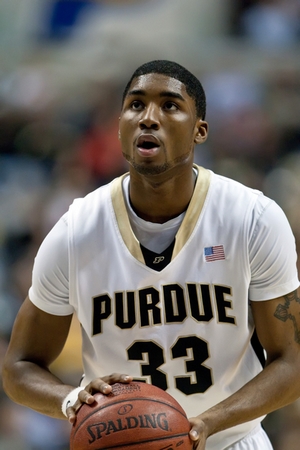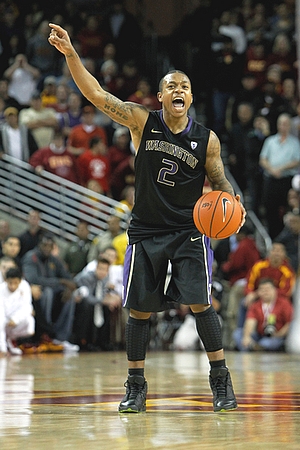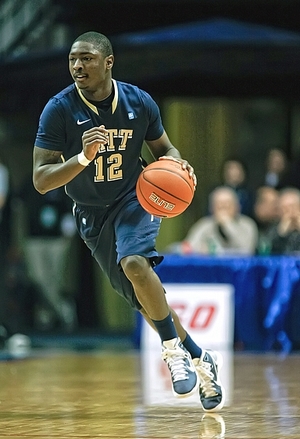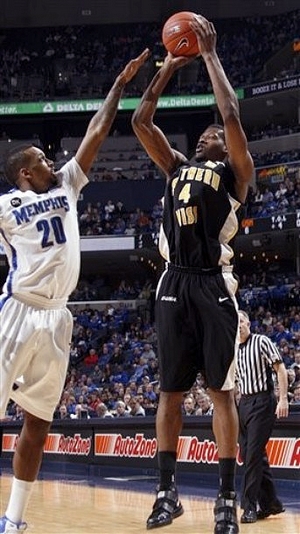-Trending Prospects (1/20) Tobias Harris, Travis Leslie, Malcolm Lee, Jordan Williams
-Trending Prospects (1/14) Darius Morris, Marshon Brooks, Delvon Johnson, Matthew Bryan-Amaning
-Trending Prospects (1/6) Justin Harper, Nikola Vucevic, Andrew Goudelock, Trevor Mbakwe
-Trending Prospects (12/30) Keith Benson, Tristan Thompson, Klay Thompson, Quincy Acy
-Trending Prospects (12/23) Khris Middleton, Markieff Morris, Keith Clanton, Orlando Johnson
-Trending Prospects (12/16) Scotty Hopson, Rick Jackson, Festus Ezeli, Brad Wanamaker
-Trending Prospects (12/9) Brandon Knight, Demetri McCamey, David Lighty, Justin Holiday
-Trending Prospects (12/2) Terrence Jones, Reggie Jackson, Charles Jenkins, Steven Gray
JaJuan Johnson, 6-10, Power Forward, Senior, Purdue
20.6 points, 7.8 rebounds, 1.0 assists, 1.5 turnovers, .9 steals, 2.2 blocks, 51% FG, 79% FT, 36%
/1296155904.jpg)
Derek Bodner
With Robbie Hummel missing the year after re-injuring his ACL in practice before the start of the season, senior JaJuan Johnson -- along with fellow senior guard E'Twaun Moore -- has had to pick up much of the scoring load for Purdue. Johnson has responded by leading the Big Ten in scoring while showing the incremental improvement we have come to expect from the lanky big man.
Sporting an improved frame, adding a good 10-15 pounds of much needed bulk, Johnson has slowly but surely expanded his offensive game each season he's been at Purdue, developing a very dependable right handed hook shot and turnaround fade away jumper over either shoulder in the post. The improvement has continued this year, as his 1.054 points per possession on post up situations is the highest of his four year career, a testament to the strength he's added. He has a very high release point on both shots, showing the ability to get the shot off over long defenders and the touch to make contested shots.
Johnson could stand to diversify his post-game, as he doesn't show much ability to use his left hand in these situations, nor much in the way of counter moves, although he has started showing signs of an up and under move he didn't have in years past. Despite solid touch and the ability to get his shot off against longer defenders, Johnson still lacks great lower body strength, which could hamper his ability to get good enough post position to consistently get quality shots at the next level. He also tends to struggle playing through contact at times and can be easily dislodged from the post.
Furthermore, there are question marks regarding whether a NBA team will be willing to run their entire half-court offense through him the way Purdue has elected to this season, as he'll likely have to transition into being much more a complimentary scorer than a go-to guy in the NBA.
Another area that has shown considerable improvement has been his perimeter jump shot. Johnson's range was primarily 15 feet and in during his freshman and sophomore seasons at Purdue, but he has extended that out to the collegiate three point line this year. Showing a high, consistent release point, this is an area of Johnson's game that could translate well to the pick and pop landscape of the NBA.
The extension of his range has manifested itself in a considerably more efficient jump shooter than last year, going from 0.804 points per shot last year on jump shots to 1.011 points per shot this year, according to Synergy Sports Technology. Besides extending his range, he's also making his jump shots at a considerably better clip, up to 46.8% this year, up nearly 7 points from last year's clip. His high release point allows him to convert on contested jump shots at a good rate, not showing the kind of drop off in efficiency many big men suffer from.
The fact that he's now a legitimate threat from beyond the college 3-point line and is converting nearly 80% of his free throws is perhaps the most notable improvement he's made this season as far as his NBA potential is concerned, as it will make his transition to the League that much smoother.
Johnson's improved range affords him increased driving lanes, and he's shown an improved ability to use one or two dribbles to setup a pull-up jump shot. However, Johnson could stand to continue improve his ball-handling, as he very little ability to utilize his left hand, and doesn't show the ability to create for himself and get to the rim, either off spot-up situations where the defender closes out too quickly or off isolations. As a whole, Johnson does very little off isolation situations outside of the post, which is something that NBA teams might be concerned about considering his lanky frame.
Defensively, Johnson is long and quick off his feet, allowing him to excel as a weak-side help defender at the college level. He does a fair job defending the pick and roll as well for a collegiate center, although at times he can be caught flat footed and slow to recover to his man.
His main issue defensively is defending the post. He does a good job of using his length to contest shots, but his lack of lower body strength really manifests itself in this aspect of his game, as he struggles to deny post position, and is easily backed down, allowing high percentage shots. Furthermore, he seems to lack a degree of toughness and aggressiveness here, as its not rare to see players pushing him around, and he doesn't always respond the way you would hope.
Johnson also struggles on the glass, averaging only 6.6 defensive rebounds per 40 minutes, pace adjusted, which places him well into the bottom half of our database. His lack of strength, toughness and inability to hold position is a clear problem here, and one that it's hard to envision him overcoming with great success.
Overall, Johnson's improving perimeter game and high release point on his finesse post moves should allow him to have a reasonable amount of success offensively at the next level playing for the right team, as long as they are willing to live with his deficiencies as a rebounder and post-defender.
His lack of strength and physical toughness looks to be his Achilles heel on both ends of the court, preventing him from being a legitimate post presence offensively and making him a liability as a defender and rebounder. These will likely be the main question marks he'll need to address moving forward, and could be the difference in whether he sticks in the NBA or not.
Despite being a college senior about to turn 22 years old, Johnson's continual, gradual improvement suggests he may continue to make incremental improvements in his game, especially if his frame continues to fill out.
E'Twaun Moore, 6-4, Senior, Shooting Guard, Purdue
18 points, 5.6 rebounds, 3.4 assists, 1.5 turnovers, 1.5 steals, 44% FG, 70% FT, 40%3P

Walker Beeken
Purdue's E'Twaun Moore has quietly put together one of the better four-year careers of any senior in college basketball this season. The Boilermaker's shooting guard has continued to show gradual improvement in all facets of his game, and while he's not the type of player who will likely wow many NBA scouts with his physical tools or upside, he's been far too productive to ignore.
With the loss of Robbie Hummel for the season with a knee injury, Moore has had to carry a larger load offensively than anticipated for Purdue, and so far he's had mixed results. Due to the Boilermakers lack of other offensive playmakers on the perimeter, Moore often finds himself attempting to create more offense than his skill set probably lends itself to, which has resulted in some inconsistency.
We've noted before that Moore lacks the ideal physical attributes for a prototypical NBA shooting guard, standing at 6'4 with just a decent frame and average athleticism, but he does possess very good scoring instincts and a nice feel for the game. This enables him to create his own shot and score effectively in one of the toughest conferences in college basketball, despite his physical limitations.
Coach Matt Painter uses Moore in a number of ways offensively in attempts to free him for shots, and Moore has shown to be a versatile shot-maker, capable of being run off screens or spotting up for catch-and-and shoot opportunities, or as the ball-handler in isolation or pick-and-roll sets. He plays at a nice pace and has a smoothness about his game, utilizing pump fakes, changing speeds, and an effective step back dribble that he uses to create space for his jump shot.
As a shooter, Moore seems to still be making strides, despite some erratic performances from game to game. While his overall field goal percentage is pretty much in line with his previous three seasons, he's shown improvement in a couple key areas. He's knocking down a solid 40% of his 3-point attempts, which is back up from the 34% he shots his past two seasons (he shot 44% as a freshman). He's also converting on 40% of his catch-and-shoot opportunities, which is a significant improvement from last season. Since Moore's game is built around his jump shot, and he won't be asked to create as many shots for himself at the NBA level, these are very encouraging signs.
Moore's lack of physical tools is more evident on dribble penetration. He has noticeably improved his handle over his four years at Purdue, but he lacks the explosive first step to blow by his man. He is crafty enough to find ways to score in the lane at the college level, shooting a respectable 55% on shot attempts in the basket area, but his lack of size and elevation would be more of an issue in trying to finish over longer, more athletic defenders in the NBA.
On the positive side, Moore has shown to have solid decision-making skills, rarely forcing the issue and playing within himself, despite often having to shoulder much of the scoring and creating responsibilities for Purdue. He regularly makes the correct read on pick and rolls, finds shooters on drive-and-kick situations, and has increased his assist rate and cut back on his turnovers this season, ranking in the top 10 of all players in our database in assist-to-turnover ratio.
Defensively, we've noted that Moore does a very good job covering the wing positions at the college level. Purdue plays a 3, or sometimes even a 4 guard lineup due to their lack of size without Hummel, and Moore has shown the ability to defend different types of players, and has even improved his rebound rate from 4.9 to 7 rebounds per forty minutes pace adjusted. When projecting how he'd fair defending NBA shooting guards, it's clear he'd be at a disadvantage physically in most matchups, but his positioning, effort, smarts, and toughness should help to compensate for that, as will his pedigree playing for one of the best defensive teams in college basketball the past four years.
Looking forward to Moore's NBA prospects, much of it will likely be dependent on finding the right situation. His physical tools are subpar by NBA two-guard standards, but he has a solid feel for the game and all around skill set, highlighted by his ability to knock down perimeter shots, defend, and fit into a system. His intangibles also appear to be superb, as indicated by the fact that he's an Academic All-American. We've seen there is a niche out there for shooting guards of his mold who can come off the bench and fill a role, such as Gary Neal, and that should earn him plenty of looks from NBA scouts as they search for players to fill out their roster.
Isaiah Thomas, 5-9, PG/SG, Junior, Washington
16.9 points, 5.8 assists, 3.9 rebounds, 1.4 steals, 2.5 turnovers, 46% FG, 36% 3PT, 72% FT

Joseph Treutlein
Playing as a combo guard and shooting guard most of his first two years in college, Isaiah Thomas' pure point guard abilities have always been somewhat of a question mark, but it appears things are starting to change. Since Abdul Gaddy went down with a torn ACL about a month ago, Thomas has been thrust into the point guard role for Washington, and the early returns have been outstanding.
Averaging a ridiculous 9.1 assists per game over the past seven games while not sacrificing any of his scoring, Thomas has fully embraced his role, playing the best basketball of his entire career. While the 5-9 guard still certainly has some question marks surrounding how his game will translate to the next level, he's gotten off to a great start quelling those doubts.
Looking at his point guard abilities, Thomas has matured substantially since we last profiled him, showing much better instincts and outstanding court vision. This 180 degree change in production and mentality as a playmaker makes all the difference in evaluating his draft stock, as it was nearly impossible to envision him making it in the NBA as a 5-9 shoot-first combo guard.
Operating at his best in transition, Thomas always keeps his head up and is capable of making hard, precise passes on the move, frequently threading the needle through the defense for spectacular plays.
In the halfcourt, Thomas is at his best operating out of the pick-and-roll, where his extremely low center of gravity and elite change of direction ability makes him a huge threat splitting double teams. He shows good ability making passes out of these situations, while also excelling on both short and deep drive-and-kicks. He does tend to show some problems making entry passes, however, being limited in potential angles at his size.
Thomas is still prone to holding onto the ball and over-dribbling at times, to be expected given the drastic role change he's undergone in three seasons, but he also shows good ability to make quick reads and get his team right into their offense, unsurprising given Washington's 14th ranked tempo according to kenpom.com.
As far as Thomas' own offense goes, he shows pretty much the same skill set as he did when he stepped onto campus as a freshman, though he's done a good job improving his decision-making over time, resulting in a steady increase in scoring efficiency, with his true shooting percentage rising from 51% as a freshman to 58% this season.
Most dangerous taking his man off the dribble, Thomas has an exceptional first step and even better ability to change directions with the ball, boasting a great crossover and very good control in the lane. He is fearless in drawing contact, getting to the free-throw line at a very high rate, though he struggles scoring over help-side defenders and gets bailed out on foul calls at this level far more often than he will in the pros.
Relying heavily on a finesse game scoring in the lane, Thomas uses a lot of floaters and runners to get the job done, which is probably inevitable at his height. While Thomas' ability to score points around the basket is one of his strengths at this level, it's not hard to see it becoming a weakness in the pros, where the change in size and athleticism will have a strong effect on his game.
As a shooter, Thomas has done a good job steadily improving his three-point scoring efficiency his three years in college, being a respectable spot-up shooter from deep and solid coming off screens as well. He shows a significant tendency to jump into his shots to generate power, much more noticeable as he gets closer to NBA three-point range, something that can be problematic when he's pressed for time.
Off the dribble, Thomas is a very unreliable shooter, struggling to get the separation needed to get off his shot, as he needs more room given his height and his tendency to jump forward. To his credit, however, these problems are far less noticeable when he's operating out of pick-and-rolls, as the threat of his speed combined with the screen allow him to generate more space for his shot.
Defensively, Thomas' size poses some obvious problems, the most evident of which is the relative ease opponents have shooting over him, even though he does the best he can to contest shots. Thomas' effort level and fundamentals have improved substantially on this end during his time in college, and his lateral quickness and ability to change direction are both excellent.
He probably excels the most sticking to his man off the ball and playing prevent defense, being very hard to shake given his ability to change direction combined with his outstanding quickness, though this strength will probably be muted some at the next level against larger, quicker opponents. Off the ball, he shows great anticipation for steals, but his size and length limits him from making as many impact plays as he otherwise could.
Looking forward, Thomas has done a great job addressing many of the key concerns with his game over the past two seasons, and with Abdul Gaddy out for the season and Washington having another 11 games on their schedule before postseason play begins, Thomas has a ton of opportunity to continue showing off his game. His prowess and comfort level in the pick-and-roll combined with his outstanding speed off the dribble give him a definite chance to make a living in the NBA, especially if he continues to play at the level he has recently.
Ashton Gibbs, 6'2, Junior, Point Guard, Pittsburgh
15.5 Points, 2.3 Rebounds, 3.3 Assists, 42.4% FG, 44.5% 3P, 87.5% FT

Matt Williams
Ranking as arguably the best shooter of any player in our database, Ashton Gibbs is the leading scorer on a highly touted Pittsburgh team running the gauntlet that is Big East play.
Gibbs is a prolific zone buster for one of the best teams in the NCAA, and while his role doesn't seem consistent with what is expected of most NBA point guards, he's clearly an outstanding college player who plays low mistake basketball.
Standing 6'2 with a decent frame, Gibbs has solid quickness for a guard at the college level, but is a below average athlete and undersized for the position by NBA standards. While Gibbs doesn't function as a pure point guard regularly next to Brad Wanamaker, he is a capable passer with good vision. His ability to show that he can handle the ball under pressure and make the easy pass instead of trying to create his own shot will be areas of interest next season with Wanamaker out of the picture, since his physical profile projects much better to the point guard spot.
Though Gibbs doesn't look the part of a NBA point guard with the way he operates in Pitt's incredibly unique offense (ranked #1 in the country right now in efficiency), he unquestionably looks like a NBA caliber jump shooter. With more than half of his shots coming from beyond the arc and a ridiculous 91% of his shots coming from perimeter jumpers, Gibbs relies on his catch and shoot ability to score. Shooting the ball with an extremely quick release, but little elevation, Gibbs has knocked down a remarkable 49.1% of his catch and shoot attempts according to Synergy Sports Technology.
With so many of his shots coming from the perimeter, Gibbs doesn't get the opportunity to handle the ball too frequently in pick and roll and transition situations or create many easy looks for himself at the rim. Lacking great physical strength and ball-handling ability, he does a nice job using screens to create separation for his jumper when he does operate in the two-man-game, but struggles to accomplish the same one-on-one and seldom gets all the way to the rim when he tries to drive. Opting for floaters in the middle of the lane, Gibbs has made 5 of his 18 runners and shots around the rim in the half-court through 21 games this season.
Defensively, Gibbs plays with the energy that is common amongst guards coached by Jamie Dixon. He plays hard and does his best to apply pressure, but simply doesn't have the lateral quickness to consistently deny penetration, especially when his matchup changes directions with the ball. A step slow getting over screens at times, Gibbs isn't a playmaker defensively, but he doesn't take risks either, as is an extremely solid player for Pitt on this end of the floor.
At this juncture, Gibbs still has some room to grow on the college level and a full season to show that he can effectively man the point guard position. He doesn't have the tools to be a top NBA floor general and simply doesn't fit in many NBA systems (heavily oriented around the pick and roll game), but he seems capable of playing a role similar to the one Mario Chalmers is playing right now for the Heat, or Steve Blake for the Lakers.
An early favorite for a spot at the Portsmouth Invitational Tournament in 2012, Gibbs has some clear-cut strengths which are very much in demand, but needs to continue to work on diversifying his game to make himself more attractive to the NBA.
Gary Flowers, 6-8, Senior, Forward, Southern Mississippi
20.6 points, 7.2 rebounds, 1.1 assists, 2.7 turnovers, 0.9 steals, 1.8 blocks, 50.0% FG, 42.9% 3FG, 76.3% FT

Kyle Nelson
After showing potential as a junior, Southern Mississippi forward Gary Flowers has made significant strides thus far during his senior season.
As has been written in the past, Flowers has above-average size for a combo-forward with good length to compensate. In addition, he is a fluid athlete, which makes his tweener skill-set more adaptable to the next level.
There is a lot to like about Flowers on the offensive end, as well, where he ranks amongst the best scorers in college basketball, shooting a very efficient 52% inside the arc and 44% from 3-point range. His shooting motion remains inconsistent and his jump shot gets little arc, but he has nonetheless developed into a solid perimeter shooter and a reliable pick-and-pop and spot-up threat at this level.
Inside of the arc, he continues to show potential as a face-up scorer with his growing comfort in his pull-up jump shot. He must continue to work on his ball handling, however, as he rarely is able to utilize his athleticism off the dribble and he is still very limited as a shot creator. He is a solid finisher around the basket, as well, where his quick feet, explosiveness, and soft touch off of the glass work to his advantage. While he struggles to carve out space in the post and he does not move particularly well without the ball, he has some solid post moves and can catch-and-finish.
At this stage his skill set resembles that of a face-up power forward, but his improvement and athleticism continues to suggest that with continued work he could see minutes at the small forward position in the future.
Unfortunately, Flowers has improved little on the defensive end this year, still showing the combination of mediocre fundamentals and general lack of effort that hindered him as a junior. With solid lateral quickness, length, and athleticism, he has the physical tools to be versatile, and will occasionally make a standout play, but he is, at best, a below average defender at this stage.
Gary Flowers is intriguing given his size, athleticism, and scoring ability. He will also be 25-years-old (with a checkered past) at the beginning of his rookie season, so how much more he can and will develop is unknown.
Furthermore, he has done little this season to dispel the notion that he is a tweener on the defensive end, too small to guard traditional power forwards and not solid enough to be trusted to guard small forwards, a reputation that might hurt his draft stock.
Fortunately, however, Flowers will have the opportunity to prove himself at the Portsmouth Invitational Tournament, which is well-suited to his style of play and where he can prove to scouts that he can play a role at the next level.













/1296155969.jpg)




















































Comments